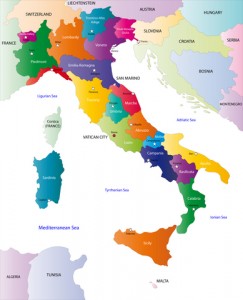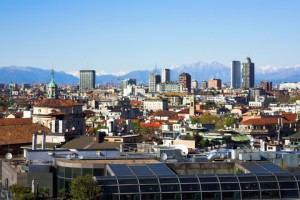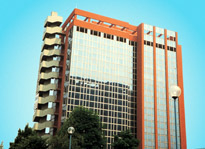
[Updated Oct 2020] A guide to serviced offices and office space for rent in Milan as well as general information that may be useful if you are thinking of renting office space in Milan.
For further offices information or to search office space for rent in Milan just click. Or contact us for any other office space query.
History & Geography
Few European cities can rival the aura that Milan, the world’s capital of style, can command. Italy’s second-largest city and the capital of the province of Lombardy is located to the north of the country in the north-west of the Po Valley, between Ticino and Adda rivers near the Italian Alps. The city was founded around 400 BCE by the Celtic tribe of the Insubres. Milan, then called Mediolanum, was subsequently conquered by Rome in 222 CE and grew quickly in power and importance. So swift was Milan’s rise to prominence that in 293 CE it was declared the capital of the Western Roman Empire by Emperor Diocletian. Later Emperor Maximian built a string of gigantic monuments in the city, including a large and intricate palace, a circus, and several other buildings, the ruins of which can still be seen in Milan today. With the collapse of the Western Roman Empire Milan was left vulnerable and in 452 CE was overrun by the Huns, and later in 593 CE it was the turn of the Ostrogoths to invade and then sack the city. In 774 CE the legendary Frankish King Charlemagne took the city and named himself King of the Lombards. In the Middle Ages, despite a turbulent political life, Milan prospered and became a centre of trade and commerce. In the 16th century the city fell under the sway of the House of Habsburg and in the same century was ravaged terribly by the Bubonic Plague. In the 19th century, Milan came under the sway of the French under Napoleon and after his demise the Austrians, against whom the Milanese people rebelled in 1856. Eventually, the city was incorporated into the Kingdom of Italy and continued to grow in importance, especially in the financial sphere. The late 19th and early 20th centuries saw the city’s population swell and the city’s borders expand. Milan was badly bombed by the Allies during the WWII, however afterwards benefited from Italy’s Economic Miracle in the 1950s and 60s. Today the city is known for its influence in fashion, design, sport, industry, commerce, art and media, as well as being a popular destination for tourists.
Economy
Milan is one of the most important business and financial centres in the world and traditionally has a very strong economy. Were Milan a country it would rank as the 28th largest economy in the world and the metropolitan area has the 4th highest GDP in Europe. As well as being the home of the Italian Stock Exchange, Milan has a cornucopia of thriving industries such as textiles, auto manufacturing, chemicals, heavy machinery and publishing. Of course, Milan is also one of the world’s most important cities for industrial and modern design, hosting a variety of design events and fairs every year. Additionally, the city is well known as one of the foremost fashion capitals of the world. Most of the major Italian fashion brands are headquartered in the city, including Valentino, Gucci, Versace, Prada, Armani and Dolce & Gabbana.
 Tourism
Tourism
Every year Milan plays host to almost two million tourists and is currently one of Europe’s most important tourist destinations. Milan has a selection of buildings and sites that are very important for the tourist industry, including the Duomo and Piazza, the Convent of Sta. Maria delle Grazi which contains Leonardo da Vinci’s The Last Supper, the Teatro alla Scala, the Brera Academy and the Via Monte Napoleone. Sports aficionados will not want to miss the San Siro Stadium, home to both the city’s famous football clubs, AC Milan and Inter Milan. Like most other Italian cities Milan has its own distinctive cuisine, of which the most famous dish is cotoletta ala Milanese, a breaded veal cutlet pan-fried in butter, similar to Wienerschnitzel. Milan has many restaurants and cafes, the most popular and traditional of which can be found in the Brera and Navigli districts. The best-known café is Caffe Cova, which was founded in 1817 near the Teatro alla Scala. Many visitors come to Milan for the shopping, and the city’s main shopping areas are Monte Napoleone, Via della Spiga, Via Manzoni, Corso Buenos Aires, Via Dante and the Piazza del Duomo.
Transport
Milan also serves as a transport hub for the region. The city has five main railway stations, of which Milan Central Station is the busiest. High-speed trains link Milan with Bologna, Florence, Rome, Naples and Salerno. The city’s public transport system is managed by the Azienda Trasporti Milanesi which operates an underground rapid transit system, buses, trolleys and trams. Milan also operates bike-sharing and car-sharing systems. The city has three international airports, the Malpensa International Airport, which is the largest of the three, the Linate Airport and Orio al Serio.

Office Space to rent in Milan
Milan’s office market suffered in the aftermath of the financial crisis however of late has revived. In the first half of this year, take-up increased a full 57 percent compared with the same period last year. Currently, the average rent is EUR 520 per square metre per year and the vacancy rate is standing at 9.3 percent. However, there is a fair amount of variation in the vacancy rate depending on the area. In the centre, it is at approximately 5 percent or lower, whereas in the periphery it is at 12 percent. Milan’s CBD currently suffers from a lack of available space so many believe other districts such as the Republica Garibaldi Zone and the Milanofiori areas will become more prominent. However, currently, demand is still strongest in the CBD.
We carry out a free office space search and our advisory and acquisition services are also free, always. Our Jacksonville office space brokers and agents are globally regulated by the Royal Institution of Chartered Surveyors (RICS) ensuring the highest standards of commercial property advice and service at all times. We look forward to helping you find the best office space for rent for your business.

The Office Providers are Regulated by the Royal Institution of Chartered Surveyors (RICS)